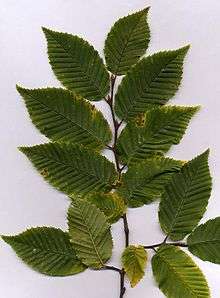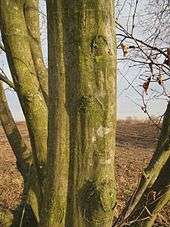Hornbeam
Hornbeams are hardwood trees in the flowering plant genus Carpinus in the birch family Betulaceae. The 30–40 species occur across much of the temperate regions of the Northern Hemisphere.
| Hornbeam | |
|---|---|
 | |
| European hornbeam foliage | |
| Scientific classification | |
| Kingdom: | Plantae |
| Clade: | Tracheophytes |
| Clade: | Angiosperms |
| Clade: | Eudicots |
| Clade: | Rosids |
| Order: | Fagales |
| Family: | Betulaceae |
| Subfamily: | Coryloideae |
| Genus: | Carpinus L. |
| Synonyms[1] | |
|
Distegocarpus Siebold & Zucc | |
Origin of names
The common English name hornbeam derives from the hardness of the woods (likened to horn) and the Old English beam "tree" (cognate with German Baum). The American hornbeam is also occasionally known as blue-beech, ironwood, or musclewood, the first from the resemblance of the bark to that of the American beech Fagus grandifolia, the other two from the hardness of the wood and the muscular appearance of the trunk, respectively. The botanic name for the genus, Carpinus, is the original Latin name for the European species.
Taxonomy
Though some botanists grouped them with the hazels (Corylus) and hop-hornbeams (Ostrya) in a segregated family, Corylaceae, modern botanists place the hornbeams in the birch subfamily Coryloideae.
Description
Hornbeams are small to medium-sized trees, Carpinus betulus reaching a height of 32 m.[2]:296 The leaves are deciduous, alternate, and simple with a serrated margin, and typically vary from 3–10 cm in length. The flowers are wind-pollinated pendulous catkins, produced in spring. The male and female flowers are on separate catkins, but on the same tree (monoecious). The fruit is a small nut about 3–6 mm long, held in a leafy bract; the bract may be either trilobed or simple oval, and is slightly asymmetrical. The asymmetry of the seedwing makes it spin as it falls, improving wind dispersal. The shape of the wing is important in the identification of different hornbeam species. Typically, 10–30 seeds are on each seed catkin.
Distribution
The 30–40 species occur across much of the temperate regions of the northern hemisphere, with the greatest number of species in east Asia, particularly China. Only two species occur in Europe, only one in eastern North America, and one in Mesoamerica.[1][3][4][5][6] Carpinus betulus can be found in Europe, Turkey and Ukraine.[7]
Associated insects
Hornbeams are used as food plants by the larvae of some Lepidoptera species, including autumnal moth, common emerald, feathered thorn, walnut sphinx, Svensson's copper underwing, and winter moth (recorded on European hornbeam) as well as the Coleophora case-bearers C. currucipennella and C. ostryae.[8]
Applications

Hornbeams yield a very hard timber, giving rise to the name "ironwood".[9] Dried heartwood billets are nearly white and are suitable for decorative use. For general carpentry, hornbeam is rarely used, partly due to the difficulty of working it. The wood is used to construct carving boards, tool handles, handplane soles, coach wheels, piano actions, shoe lasts, and other products where a very tough, hard wood is required. The wood can also be used as gear pegs in simple machines, including traditional windmills.[9] It is sometimes coppiced to provide hardwood poles. It is also used in parquet flooring and for making chess pieces.
Species
Accepted species:[1]
- Carpinus betulus L. – European hornbeam - widespread across much of Europe; Turkey, Iran, Caucasus; naturalized in a few places in US.[7]
- Carpinus caroliniana Walter – American hornbeam - Quebec, Ontario, eastern half of US
- Carpinus chuniana Hu – Guangdong, Guizhou, Hubei
- Carpinus cordata Blume – Sawa hornbeam - Primorye, China, Korea, Japan
- Carpinus dayongiana K.W.Liu & Q.Z.Lin – Hunan
- Carpinus eximia Nakai – Korea
- Carpinus faginea Lindl. – Nepal, Himalayas of northern India
- Carpinus fangiana Hu[10] – Sichuan, Guangxi
- Carpinus hebestroma Yamam. – Taiwan
- Carpinus henryana (H.J.P.Winkl.) H.J.P.Winkl. – southern China
- Carpinus japonica Blume – Japanese hornbeam - Japan
- Carpinus kawakamii Hayata – Taiwan, southeastern China
- Carpinus kweichowensis Hu – Guizhou, Yunnan
- Carpinus langaoensis Z. Qiang Lu & J. Quan Liu – Shaanxi, China
- Carpinus laxiflora (Siebold & Zucc.) Blume – Aka-shide hornbeam - Japan, Korea
- Carpinus lipoensis Y.K.Li – Guizhou
- Carpinus londoniana H.J.P.Winkl. – southern China, northern Indochina
- Carpinus luochengensis J.Y.Liang – Guangxi
- Carpinus mengshanensis S.B.Liang & F.Z.Zhao – Shandong
- Carpinus microphylla Z.C.Chen ex Y.S.Wang & J.P.Huang – Guangxi
- Carpinus mollicoma Hu – Tibet, Sichuan, Yunnan
- Carpinus monbeigiana Hand.-Mazz. – Tibet, Yunnan
- Carpinus omeiensis Hu & W.P.Fang – Sichuan, Guizhou
- Carpinus orientalis Mill. – Oriental hornbeam - Hungary, Balkans, Italy, Crimea, Turkey, Iran, Caucasus
- Carpinus paohsingensis W.Y.Hsia – China
- Carpinus polyneura Franch. – southern China
- Carpinus pubescens Burkill – China, Vietnam
- Carpinus purpurinervis Hu – Guizhou, Guangxi
- Carpinus putoensis W.C.Cheng – Putuo hornbeam - Zhejiang
- Carpinus rankanensis Hayata – Taiwan
- Carpinus rupestris A.Camus – Yunnan, Guangxi, Guizhou
- Carpinus shensiensis Hu – Gansu, Shaanxi
- Carpinus shimenensis C.J.Qi – Hunan
- †Carpinus tengshongensis W.C.Cheng[11] – Zhejiang but probably extinct
- Carpinus tropicalis (Donn.Sm.) Lundell – Mexico, Central America
- Carpinus tsaiana Hu – Yunnan, Guizhou
- Carpinus tschonoskii Maxim. – Chonowski's hornbeam - China, Korea, Japan
- Carpinus turczaninowii Hance – Korean hornbeam,[12] - China, Korea, Japan
- Carpinus viminea Wall. ex Lindl. – China, Korea, Himalayas, northern Indochina
References
- "Carpinus L., Sp. Pl.: 998 (1753)". World Checklist of Selected Plant Families. Royal Botanic Gardens, Kew.
- Stace, C. A. (2010). New Flora of the British Isles (Third ed.). Cambridge, UK: Cambridge University Press. ISBN 9780521707725.
- Flora of China, Vol. 4 Page 289, 鹅耳枥属 e er li shu, Carpinus Linnaeus, Sp. Pl. 2: 998. 1753.
- Flora of North America, Vol. 3, Hornbeam, Carpinus Linnaeus, Sp. Pl. 2: 998. 1753; Gen. Pl. ed. 5, 432, 1754.
- "Carpinus betulus L." Altervista Flora Italiana.
- "2013 BONAP North American Plant Atlas. TaxonMaps". Biota of North America Program.
- Carpinus betulus. 2.nd Ed., The Royal Horticultural Society, Dorling Kindersley Ltd, London, pp. 234, 235.
- Miscellaneous Publication. U.S. Department of Agriculture. 1972. p. 297.
- Eichhorn, Markus; Haran, Brady (2011-12-01). "The Hornbeam's Heartbeat". test-tube.org.uk. University of Nottingham. Retrieved 2012-12-30.
- "Carpinus fangiana". Rogers Trees and Shrubs. Archived from the original on 2011-07-15.
- Dai, Jing; Sun, Bainian; Xie, Sanping; Lin, Zhicheng; Wu, Jingyu; Dao, Kequn (2013). "A new species of Carpinus (Betulaceae) from the Pliocene of Yunnan Province, China". Plant Systematics and Evolution. 299 (3): 643–658. doi:10.1007/s00606-012-0750-1.
- English Names for Korean Native Plants (PDF). Pocheon: Korea National Arboretum. 2015. p. 400. ISBN 978-89-97450-98-5. Archived from the original (PDF) on 25 May 2017. Retrieved 8 December 2016 – via Korea Forest Service.
External links
| Wikimedia Commons has media related to Carpinus. |
| Look up hornbeam in Wiktionary, the free dictionary. |
| Wikisource has the text of the 1911 Encyclopædia Britannica article Hornbeam. |
- Eichhorn, Markus (December 2011). "Hornbeam". Test Tube. Brady Haran for the University of Nottingham.